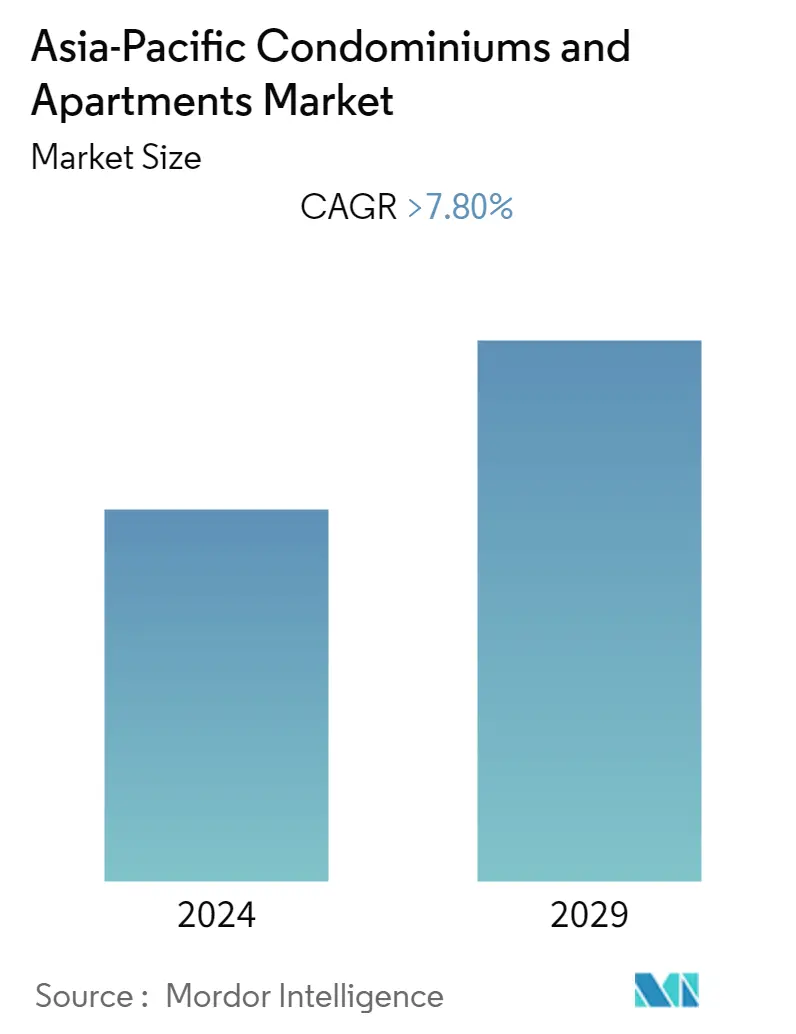Market Size of Asia-Pacific Condominiums and Apartments Industry

| Study Period | 2020 - 2029 |
| Base Year For Estimation | 2023 |
| Forecast Data Period | 2024 - 2029 |
| Historical Data Period | 2020 - 2022 |
| CAGR | > 7.80 % |
| Market Concentration | Low |
Major Players
*Disclaimer: Major Players sorted in no particular order |
Need a report that reflects how COVID-19 has impacted this market and its growth?
APAC Condominiums & Apartments Market Analysis
The size of the Asia-Pacific Condominiums and Apartments Market is anticipated to register a CAGR of over 7.8% during the forecast period. The market is driven by the huge investments in the region's residential real estate and the need for multifamily and affordable housing.
- According to JLL, the lower investment volume is due to "a variety of macroeconomic factors," such as fewer trades in major markets, the region's currencies appreciating against the US dollar, and aggressive tightening of the US interest rates. Despite ongoing macroeconomic challenges, inflationary concerns, and rising debt costs, investors remain broadly positive on the region's real estate. They intend to expand their footprint in the region in the medium to long term. In Singapore, investment volumes totalled USD 2.3 billion in Q3 2022, down from USD 3.6 billion in the previous quarter. JLL attributes the drop to lengthy negotiations on major office deals as a result of widening price disparities between buyers and sellers. On the other hand, the volume represents a 116% improvement Y-o-Y, coming off of a low base in Q3 2021.
- For investors looking to invest in Asia-Pacific multifamily, the first port of call is invariably Japan, which has the region's most mature and largest market, attracting billions of dollars in investment each year. Australia is the only other country with a developing institutional-grade multifamily residential market. Other countries in the region have markets dominated by build-to-sell activities and limited availability of institutional products. Japan and Australia have the "most pronounced appetite" in Asia-Pacific for living products. China, South Korea, New Zealand, and India have less mature markets, with regulatory, development, and investment uncertainty weighing on activity. However, these markets have tremendous demographic trends, strong economies, and high demand for housing. The first movers may enjoy "considerable" benefits like capital appreciation returns.
- Rentals for HDB flats and private apartments increased in August 2022, and the trend shows no signs of abating. According to flash figures released by property portals 99.co and SRX, HDB rents increased by 2.4% in August 2022, compared to 1.5% in July, with rents rising across all flat types in both mature and non-mature estates. Condominium rents increased by 3.2% in August 2022, compared to 1.7% the previous month, with central Singapore experiencing the fastest growth at 3.7%. One of the reasons is that rising rental rates are putting a financial strain on many young locals considering renting their place.
- The 2022 ULI Asia Pacific Home Attainability Index examines home attainability in 28 cities across five Asia-Pacific countries, including Australia, China, Japan, Singapore, and South Korea. These countries have a combined population of about 1.8 billion or about 21% of the world's population. According to the median private home price to median annual household income ratio, Shenzhen, China, was deemed the least affordable, with more than 40 times the median income, followed by Hong Kong SAR, with more than 30 times, followed by Beijing and Shanghai. Shenzhen had the least amount of new housing stock among major Chinese cities over the last decade compared to population growth. Simultaneously, the city has a significant amount of informal housing, which means homes without legal titles that are not included in official private housing sector data and, thus, not included in the home attainability index. Informal housing stock, which is estimated to account for around 30% of total housing stock, is primarily used by migrants and low-income households.
